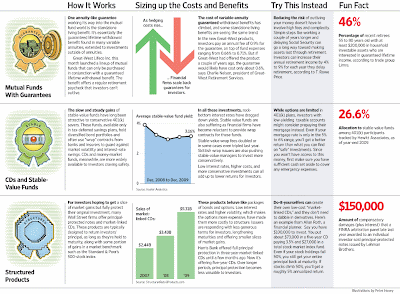The Price Of Safety Just Went Up
Volatility, low rates and skittish firms are squeezing investors.
By ELEANOR LAISE
Investors battered by market upheaval, including a 6% stock slide in recent weeks, have a new mantra for their portfolios: preserve, protect and defend. But they should be prepared to pay up.
Ray Bartkus
 The price of portfolio safety is soaring. Low interest rates and high market volatility make it more expensive to construct products offering income guarantees, downside protection, and other sleep-at-night features. On top of that, Wall Street firms, still skittish from the financial crisis, are reluctant to offer generous guarantees.
The price of portfolio safety is soaring. Low interest rates and high market volatility make it more expensive to construct products offering income guarantees, downside protection, and other sleep-at-night features. On top of that, Wall Street firms, still skittish from the financial crisis, are reluctant to offer generous guarantees.
It all adds up to a dubious proposition for safety-seeking investors: Pay more for less.
Consider the most straightforward of "safe" investments. With the Federal Reserve holding short-term interest rates close to zero, the seven-day yield on taxable money-market funds recently sank to a record low 0.02%, and the average six-month bank certificate of deposit yields less than 0.5%.
Risk-averse savers looking to improve on those rock-bottom rates find a panoply of often confusing and increasingly expensive options. One of the biggest sellers is still variable annuities, which are stock and bond funds sold with an insurance wrapper. The insurance industry got burned in the financial crisis after it offered overly optimistic income guarantees. It has since reined them in.
Now the fund industry is pitching mutual funds with annuity-like guarantees. Investors pay an extra fee in exchange for a lifetime income guarantee. But as with variable annuities, that guarantee is considerably pricier than it would have been a couple of years ago.
Those who want stability can put their 401(k) money into stable-value funds designed to protect principal and provide relatively low, steady returns. But those funds' yields have fallen sharply over the past year. Another option is principal-protected notes and market-linked CDs that promise to return 100% of investors' principal if held to maturity. The bad news is that issuers are lengthening the period before the guarantee kicks in--in essence making the principal protection less valuable to investors.
Finally, there are products designed to sound safe that don't actually guarantee anything. Putnam Investments has lured about $1.3 billion over the past year or so to its four Absolute Return funds, which target annual returns of 1, 3, 5 or 7 percentage points over Treasury bills, respectively. The cheapest fund in the lineup is Absolute Return 100, which charges 1.25% annually. But since it is aiming to deliver returns of 1 percentage point over Treasury bills, it is comparable to a short-term bond fund, and the average fund in that category charges 0.92%, according to investment-research firm Morningstar Inc. What is more, in the 12 months ending Thursday, investors would have been better off in the average short-term bond fund, which gained more than 9%, versus a roughly 4% gain for the Absolute Return 100 Fund.
Jeff Carney, global head of marketing, products and retirement at Putnam, says the fees are justified in part because the funds use sophisticated strategies like trading derivatives and "shorting," or selling a borrowed security in hope of buying it back later at a lower price. These strategies should help the funds meet their objectives while minimizing risk, he says.
Safety Sells illustrations by Peter Hooey,(to enlarge click on http://online.wsj.com/media/wsj_SAFETYb100212.gif) to see a deeper look at some of the "safe" products you're likely to encounter.

But the funds' sizable fees "force the managers to take on a little more risk" than they would need to if expenses were lower, says Jonathan Rahbar, mutual-fund analyst at Morningstar.
There are simpler, and often cheaper, ways for investors to boost portfolio safety. It doesn't take a financial engineering degree, for example, to make your own sort of "market-linked CD" that guarantees you will get back your principal even in the event of a market meltdown.
Wall Street has little incentive to sweeten the terms on its complex products as long as investors demonstrate such a tremendous appetite for safety and stability. Last year, investors yanked $8.8 billion out of stock mutual funds and poured $306 billion into more-sedate taxable bond funds.
Even the wealthiest investors are getting much more conservative. Among U.S. households with a net worth of $5 million to $25 million, 27% describe themselves as "conservative" investors in 2009, up from 5% a year earlier, according to Spectrem Group.
Copyright 2009 Dow Jones & Company, Inc. All Rights Reserved
0 comments:
Publicar un comentario